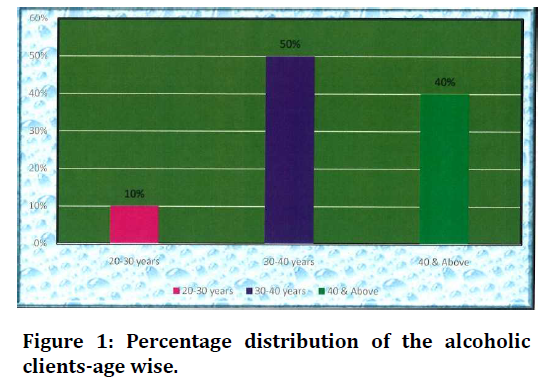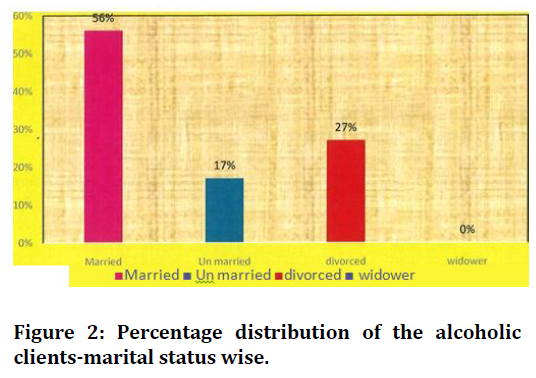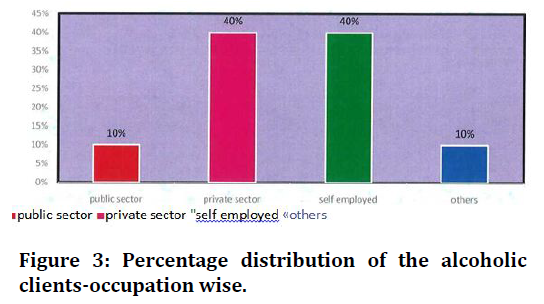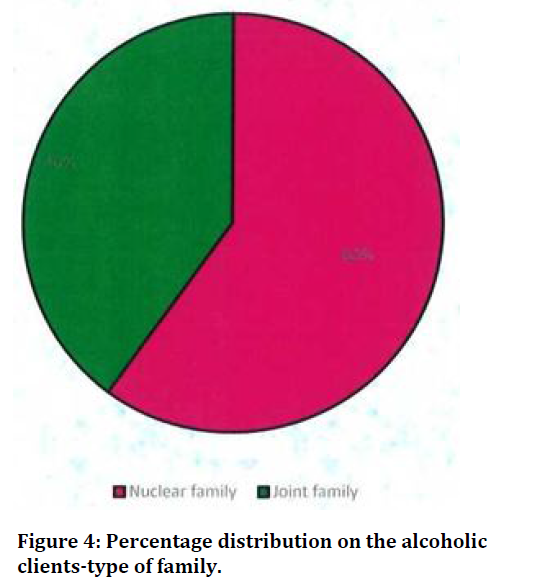Research - (2021) Volume 9, Issue 10
A Descriptive Study to Assess the Emotional Problems Among Alcoholic Clients in De-Addiction Ward, Institute of Mental Health, at Chennai
G Esther, K Divya and AR Bharathi*
*Correspondence: AR Bharathi, Department of Nursing, Bharath Institute of Higher Education and Research, India, Email:
Abstract
Background: Emotional problem is an inability to build or maintain satisfactory interpersonal relationship with peers or others. Through education driven can control emotional problems of alcoholic clients and to promote well - being of the alcoholic clients. Methods: The sample was selected by simple randomized sampling technique (n=30). Level of emotional problem among the alcoholic clients was assessed by emotional contagion scale with the selected demographic variable. The levels of emotional problems were associated by chi- square test. Results: The result of descriptive study shows the level of emotional problems among alcoholic clients. The overall percentage is (10%) most susceptible emotional problems, (77%) moderate susceptible emotional problems, (10%) mild susceptible emotional problems, (3%) normal susceptible. Conclusion: The above finding reveals that the emotional contagion scale was effective to assess the emotional problems among the alcoholic clients.
Keywords
Cirrhosis, Gluconeogenesis, Fatty acid, Atherosclerosis
Introduction
Using the first five waves of the us health and Retirement separation and divorce for 5655 married couples. They during up to from repeated two years follow-up periods. They found that drinking status was positively correlated between spouses. The correlation did not increase over the follow-up periods.
Controlling for current consumption levels, a history of problems drinking by either spouses was not signification associate with an increased probability of divorce. determine the personality of twenty alcoholic in client aged using the multi-phase questionnaires [MPE] and the role of age of consent of drinking, age of problems drinking before mid-thirty and after crossing mid thirty’s chronicity and performance quotient [p] in relation to the [MPQ] profile result show highest loading on depression 66 percentage and lowest on anxiety three percentage.
A significant correlation was found between scale of psychopathic deviance and poor PQ level were associated with depression and psychopathic deviance clinical diagnosis was correlated by the finding of the MPQ [1-3]. Conducted their assess the knowledge of parental psychiatric problems are associated with problem and problem behaviour in adolescents in a clinical sample of two outpatient adolescent age thirteen and fourteen years boys thirty percentage and their parents. The adolescent were assessed using the structural clinical review for DSM -III-R [SCID] and semi questionnaires.
The finding indicates that parent psychiatric problems and alcohol are correlated with assessed when studying adolescents [4,5], studied situational assessment of alcohol related coping skills in wives of alcoholics he used administered to forty five middle age wives of alcoholic general ability analysis indicated that most of the variance in performing was accounted by cross-situational difference among samples AI-Anon experienced samples scored significantly higher than those with little or no AInon experienced situational assessment of alcohol related coping skills shows promise as refined method for identifying specific skill deficits in wives of alcoholics [6].
Compared the level of aspiration in fifty male alcoholism and fifty male non alcoholism, as measured by the selfanchoring striving scale, alcoholic subject were defined as consuming at least of aspiration among non-alcoholic, growth motivation in alcoholic was reduced over five year suggesting stagnation Investigation of the possible association between alcohol consumption and eight types problems behaviour lives of a sample of 5665 british adult, it also examines gender difference [7].
The aggressive sexual behaviour alcohol -dependent men and its implication in clinical practice. A Total of thirty women of male alcohol dependent patients were taken from a psychiatric clinic and matched with a control group of spouse of healthy none drinking non for variables of age, gender, ethnicity, and social class.
These group were tested for sexually induced mark over a one month period area of the body that were marked, during of body marks and lovemaking experienced of finding indicates that spouses of alcohol dependent men are subject to more aggressive and painful sexual experiences, more body mark in more region that lasted an average of seven aged fifteen aged fifteen to twenty for comparative purpose, a sample of thirty non addicted matched control was selected.
Results indicate that alcohol addicts differ from normal consumer [8,9]. The quantitative changing in the degree of depression and anxiety among alcohol dependent case during and after detoxication [10] year old alcohol dependent inpatient of the drugs de-addition unit a hospital in new Delhi, India were rated based on the Hamilton Anxiety and depression scales and back depression inventory one week after admission to avoid the impact of withdrawal symptoms on assessment, Reassessment was conducted complete the treatment after month, Result showed that the scores on the anxiety and depression scale were considerably lower during post detoxification period assessment the during admission [11] conducted a study in tertiary centre on psychiatric co-morbidity in alcohol dependent in 2012 with sample size of thirty consecutive patient meeting DSM IV criteria for alcoholism.
These patients were interviewed on structured clinical interview for DSM IV SCID for arriving at DSM IN AXIS-I and AXIS-II diagnosis. conducted a retrospective study on patients at de-addiction treatment in Tamil Nadu. Alcohol dependence, poly substance dependence of use and comorbidity in 656 new patients who admitted in between the year 1999-2010 were collected analyzed among majority of patients were alcohol dependent 3.8% of alcoholic patients have emotional anxiety disorder 2.6% alcohol dependence patient had personality behavior disorder found and 21.6% alcohol dependence schizophrenia [12].
In their study of self-concept, anxiety and adjustment among anxiety neurotics, alcoholic and normal. Twenty male Indian subjects [13-45] were divided into three groups, anxiety neurotics, alcoholics and normal. Data show that normal had higher soft concepts, lower anxiety and better adjustment. Both alcoholics and anxiety and social maladjustment.
Assessed pathway in patients with alcoholic addiction, alcoholic cirrhosis, and acquire in their pathogenesis’s also was studied. In the patient group there was elevated design synthesis increased and alcoholic and glycoconjugate levels and low ubiquinone and elevated free radical levels.
There was an increased in tryptophan catabolises and a reduction in a tyrosine catabolises as well as reduced endogenous morphine synthesis from tyrosine there was an increase in cholesterol phospholipids ratio and a reduction in glycoconjugate level of RBC members in this group of patients [13-15]. Alcoholics cirrhosis, Alcoholic addiction and acquired hepato cerebral degeneration were Associated up regulated isolprenoid pathway and elevated dioxin secretion from hypothalamus this can contribute to NMDA Excitoxicity and altered connective tissue or lipid metabolism important in its pathogenesis. Alcoholic addiction alcoholic cirrhosis and acquired hepatocerebral degeneration occurred in right hemispheric, chemically dominant individuals.
Drug and alcohol dependence has been showing a rising trend all over the world including India, perhaps as a result of newer and greater stressors related to rapid changes in life style. The problem has received some attention in recent years. In last three decades, many surveys have been carried out in India to assess the prevalence and morbidity of alcohol users.
Methodology
Research Methodology is a Way To Systematically Solve The Research Problem . it is a Science of Studying Who Research is Done Scientifically .
This chapter deals with the brief description of varied steps under taken by the investigators for the study it in clued Research approach Research design variable settings of the study population sample and sampling technique development description the tool data collection procedure and plan for data analysis.
Target population
The target population of the study were alcoholic client who are admitted In de- addiction ward, institute of mental health, Chennai.
Accessible population
The Accessible population were alcoholic clients between (20-40 years) who met the inclusion criteria in deaddiction ward, institute of mental health, at Chennai.
Sample
The study sample was alcoholic clients with (20 - 40 years above) was available during the time of the data collection de- addiction ward, institute of mental health, at Chennai.
Sample size
A sample of 30 alcoholic clients is selected for this study.
Sampling techniques
Simple randomized sampling technique was adopted to select the samples.
Inclusion criteria
The alcoholic client who was admitted de addiction centre institute of Balaji health at Chennai.
The alcoholic client who are available during the data collection period. The alcoholic client who are willing to participate in the study.
Results and Discussion
Statistical analysis is a component of data analysis it involves collecting and scruntinizing every data sample in a set of items from which the sample can be drawn. A sample in statistical is a representative selection drawn from a total population –WHATIS This chapter deals with the analysis and interpretation of data obtained from 30 alcoholic clients who were staying in de-addiction ward of institute of mental health. The collected data were tabulated and presented according to the adjectives under the following.
Organization of data
Frequency and percentage distribution of demographic variables of the alcoholic clients Level of emotional problems among alcoholic clients associate the level of emotional problems among alcoholic clients with selected demographic variables.
Shows the demographic information of alcoholic clients those who participate in this study. Among the alcoholic clients, higher proportion (50%) of the alcoholic client belongs to the group of 30-40 years, marital stages wise (56%) of the alcoholic clients were married. As for as occupation wise (40%) private sector, (40%) selfemployed. According to their family type higher proportion is (60%) among them are nuclear family (Table 1 and Figures 1 to Figure 4).
| Demographic variables | Number of alcoholic clients (F) | Percentage (%) |
|---|---|---|
| Age | ||
| 20 - 30 years | 3 | 10% |
| 30 - 40 years | 15 | 50% |
| 40 & above | 12 | 40% |
| MARITAL STATUS | ||
| Married | 17 | 56% |
| Unmarried | 5 | 17% |
| Divorced | 8 | 27% |
| Widower | 0 | 0% |
| Occupation | ||
| Public Sector | 3 | 10% |
| Private Sector | 12 | 40% |
| Self Employed | 12 | 40% |
| Others | 3 | 10% |
| Type of family | ||
| Nuclear | 18 | 60% |
| Joint | 12 | 40% |
Table 1: Distribution of demographic variables in percentage.

Figure 1. Percentage distribution of the alcoholic clients-age wise.

Figure 2. Percentage distribution of the alcoholic clients-marital status wise.

Figure 3. Percentage distribution of the alcoholic clients-occupation wise.

Figure 4. Percentage distribution on the alcoholic clients-type of family.
Table 2 shows the level of emotional problem among alcoholic clients 77% of them had moderate susceptible emotional problem, 10% had most susceptible emotional problem, 10% had mild susceptible emotional problems, 3% had normal.
| Level OF EMOTIONAL PROBLEMS | Number of alcoholic clients(F) | Percentage (%) |
|---|---|---|
| Most susceptible | 3 | 10% |
| Moderate susceptible | 23 | 77% |
| Mild susceptible | 3 | 10% |
| Normal | 1 | 3% |
Table 2: Distribution of level of emotional problems among alcoholic clients in percentage.
Our study described socio demographic variables of the alcoholic clients regarding emotional problem among alcoholic clients; the higher population (50%) of the alcoholic clients belongs to the age group of 30-40 years, (10%) belongs to 20-30 years, (40%) below age 40 years &above. According to marital status wise higher proportion (56%) of the alcoholic clients. Belongs to the marital status of (a) marital, (27%) belongs to divorced. (17%) below marital status of unmarried,(0%) Marital status of widowers .The higher proportion (40%) of the alcoholic clients belongs to the occupation of private sector, and (40%) of the alcoholic clients belongs to the occupation of self-employed, (10%) of the alcoholic clients below to the occupation of public sector and others. According to type of family higher proportion nuclear family (60%) of the alcoholic clients [16,17]. We also asked respondents what they thought about different aspects of alcohol problem. Of those respondents who gave an opinion, around lin 5 respondents think that the majority of people with alcohol problems. Cannot recover, and there is a slight difference between looking at all adults aged 50+ and just those aged 65+ (20% and 18% respectively) [18].
Almost half of those respondent who gave an opinion, think people with alcohol problems have themselves to blame (45%for those 50+), with those aged 65+ thinking this more strongly (55%).Those aged 65% who gave an answer to this question also feel more strongly that people with alcohol problems should feel ashamed (23% compared to 17% for those 50+), however, regardless of how you group our older respondents by age, of those who gave an opinion just ever three -fourths (76%) Think that society should treat people with alcohol problems with a more tolerant attitude in addiction, a similar proportion of those aged 50+ would tell someone if they had an alcohol problem (75%).Looking just at those aged 65+ who gave opinion, it appears that they would be more reserved in telling someone, as nearly one in three (29%) say they would not someone [19-21].
Our study results shows that the level of emotional problem among the alcoholic clients are having most susceptible (10%), Moderate susceptible (77%), mild susceptible (10%), normal (3%). This study was conducted with the objective to assess the level of stress and coping strategies among the wives alcoholic, to correlate the level of stress and coping strategies among wives of alcoholics and to associate the stress and coping strategies among the wives of alcoholic with their demographic variables [22-25]. The study design descriptive correlation design 70 wives of alcoholics who fulfil the inclusive criteria were selected as sample non probability convenient sampling technique, the data was collected by using perceived stress scale and coping scale to assess the stress and coping strategies of wives of alcoholics, after getting the informed concern from participant the perceived stress and coping scale was administration, the perceived stress and coping scale was administration. The study finding revealed that majority 30(42.86%) had moderate stress, 30(42.86%) had average coping there was a positive correlation between the level stress and coping strategies situation.
Conclusion
This is the most creative part of this study. This chapter gives the brief account of the present study including summary, findings, and conclusion drawn from the findings, limitations, recommendations and nursing implication. Education is evidence based care gives the opportunity to nurses to improve their ability to identify the emotional changes in alcoholic clients. This study concluded that emotional changes in alcoholic client can be assessed using emotional contagion scale. So nurse should educate the alcoholic client to understand the importance of emotion changes on them. This chapter enlightens the importance of their research &reveals the improvement of normal behavior in alcoholic clients.
Funding
No funding sources.
Ethical Approval
The study was approved by the Institutional Ethics Committee.
Conflict of Interest
The authors declare no conflict of interest.
Acknowledgments
The encouragement and support from Bharath University, Chennai, is gratefully acknowledged. For provided the laboratory facilities to carry out the research work.
References
- Smith WS, English JD, Johnston SC. Cerebrovascular diseases. In: Fauci AS, Braunwald E, Kasper DL. Harrrison`s principles of internal medicine. 18th Edn. New York: McGraw- Hill 2011; 2:3270.
- Hatzitolios AI, Didangelos TP, Zantis AT, et al. Diabetes mellitus and cerebrovascular disease: Which are the actual data?. J Diabetes Complic 2009; 23:283 - 296.
- http://www.ebrsr.com/content/internet-stroke-center-washington-university
- Banerjee TK, Das SK . Epidemiology of stroke in India. Neurology Asia 2006; 11:1â?? 4.
- Atif MA, Ali H, Mahmood T. Frequency of carotid atherosclerosis in cerebral infarction. Pak J Med Sci 2008; 24:69-73.
- http://censusindia.gov.in/Census_Data_2001/India_at_ glance/broad.aspx
- http://www.statistics.gov.uk/cci/nugget.asp?ID=949
- DalalP, Bhattacharjee M, Vairale J, et al. UN millennium development goals: Can we halt the stroke epidemic in India? Ann Indian AcadNeurol 2007; 10:130-136.
- Mishra NK, Khadilkar SV. Stroke program for India. Ann Indian Acad Neurol 2010; 13:28-32.
- Banerjee TK, Roy MK, Bhoi KK. Is stroke increasing in India-preventive measures that need to be implemented. J Indian Med Assoc 2005; 103:162â??166.
- Dalal PM. Burden of stroke-Indian perspective. JAssoc Physicians India 2004; 52:695â??696.
- Mukherjee SC, Basu AK, Bandopadhyay B, et al. Correlation of lipid profile and carotid plaque as detected by Doppler ultrasound in ischaemic stroke patients- A hospitalâ??based study. J Indian Med Assoc 2006; 104:325.
- Bucek RA, Reiter M, Koppensteiner I, et al. B-flow evaluation of carotid arterial stenosis: initial experience. Radiology 2002; 225:295â??299.
- Hashimoto H, Tagaya M, Niki H, et al. Computer assisted analysis of heterogeneity on B-mode imaging predicts instability of asymptomatic carotid plaque. Cerebrovasc Dis 2009; 28:357-364.
- Rundek T, Arif H, Albala BB, et al. Carotid plaque, a subclinical precursor of vascular events: The Northern Manhattan study. Neurology 2008; 70:1200-1207.
- Jahromi AS, Cinà CS, Liu Y, et al. Sensitivity and specificity of color duplex ultrasound measurement in the estimation of internal carotid artery stenosis: A systematic review andmeta-analysis. J Vasc Surg 2005; 41:962â??972.
- Gunarathne A, Patel JV, Gammon B, et al. Ischemic stroke in South Asians : A review of the epidemiology, pathophysiology, andethnicity-related clinical features. Stroke 2009; 40:e415-e423.
- Gupta R, Joshi P, Mohan V, et al. Epidemiology and causation of coronary heart disease and stroke in India. Heart 2008; 94:16-26.
- American Stroke Association. Primary prevention of ischemic stroke: A guideline from the american heart association. Stroke 2006; 37:1583-1633.
- https://www.wiley.com/en-us/ABC+of+Arterial+and+Venous+Disease,+3rd+Edition-p-9781118740682
- Pandian J, Srikanth V, Read S, et al. Poverty and stroke in India: A time to act. Stroke 2007; 38:3063-3069.
- https://apps.who.int/iris/handle/10665/43314
- Murthy J. Thrombolysis for stroke in India: Miles to go Neurology India 2007; 55:3-5.
- Shah B, Mathur P. Workshop report on stroke surveillance in India. Division of noncommunicable diseases, Indian council of medical research, New Delhi 2006.
Author Info
G Esther, K Divya and AR Bharathi*
Department of Nursing, Bharath Institute of Higher Education and Research, Selaiyur, Chennai, Tamil Nadu, IndiaCitation: G Esther, K Divya, AR Bharathi,A Descriptive Study to Assess the Emotional ProblemsAmong Alcoholic Clients in De- Addiction Ward, Institute of Mental Health, at Chennai, J Res Med Dent Sci, 2021, 9(10): 152-157
Received: 17-Jul-2021 Accepted: 05-Oct-2021
